The humble cockroach may be small and innocuous, but every California homeowner knows these pests are more than just a gross little bug. Beyond most people finding cockroaches inherently disgusting, roaches cause serious health risks to your food, health, and property. Unfortunately, Californias don’t get a break from these bugs in the winter and fall. Because of California’s mild and temperate climate, every season is roach season in California. States with colder climates don’t have to worry about roaches in the winter because many species of these little pests will hibernate or die off. In the warmer months, however, roaches come back with a bang, and in states with warmer climates like southern California, roaches are a problem year-round. If temperatures indoors stay above 50 degrees, roaches can be active year-round.
What are Cockroaches?

Thousands of roaches not associated with human habitats are considered beneficial and harmless to environments.
©Cyron Ray Macey from Brisbane (-27.470963,153.026505), Australia, CC BY 2.0, via Wikimedia Commons – License
Beyond living as cold-blooded pests, Cockroaches belong to the paraphyletic group of nocturnal insects belonging to the group Blattodea which contain all group members except for termites. Over 4,600 species of these bugs exist in the world, and only about 30 associate themselves with human habitats. The other thousands of roaches not associated with human habitats benefitand natural environments resulting in only five species of cockroaches in California regarded as pests: The German cockroach, Brown-banded cockroach, Oriental cockroach, American cockroach, and Turkestan cockroach. Homeowners encounter the German cockroachthe most when battling infestation; homeowners can typically find all five of this insect species as household pests year-round in California.
German Cockroach

The German cockroach is the most common cockroach species found worldwide.
©7th Son Studio/Shutterstock.com
The most persistent roach species and considered the most troublesome is the German Cockroach. Worldwide, you will find this species the most. The bugs range from ½ inch to ⅝ of an inch long. They are defined by their light brown to tan coloring and are often characterized by two dark stripes down their back. They are golden brown or tan, and the female roach is darker than the male. These insects desire warm and humid places to call home that are also close to food and water sources. German roaches frequently invade residential properties by hitchhiking in grocery bags, cardboard boxes, and second-hand appliances.
California homeowners will most likely find a German cockroach crawling around their kitchen or bathroom and will feed on anything, including soap, glue, and toothpaste. German cockroaches are more than just annoying little pests; they have been linked to multiple harmful diseases. These insects transmit illnesses by picking up germs on the spines of their legs when they crawl through decaying matter. These germs are transferred to food and other surfaces that people commonly touch.
German cockroaches live in warm, humid, and dark areas occupying tight spaces around sinks and in the walls. The German cockroach is very common and hides in people’s homes, which isn’t surprising because of how fast they spread and reproduce. A female cockroach can start a breeding explosion of up to 30,000 roaches annually. German cockroaches are not tolerant to cold and depend on temperate environments for survival.
Brown-banded Cockroach
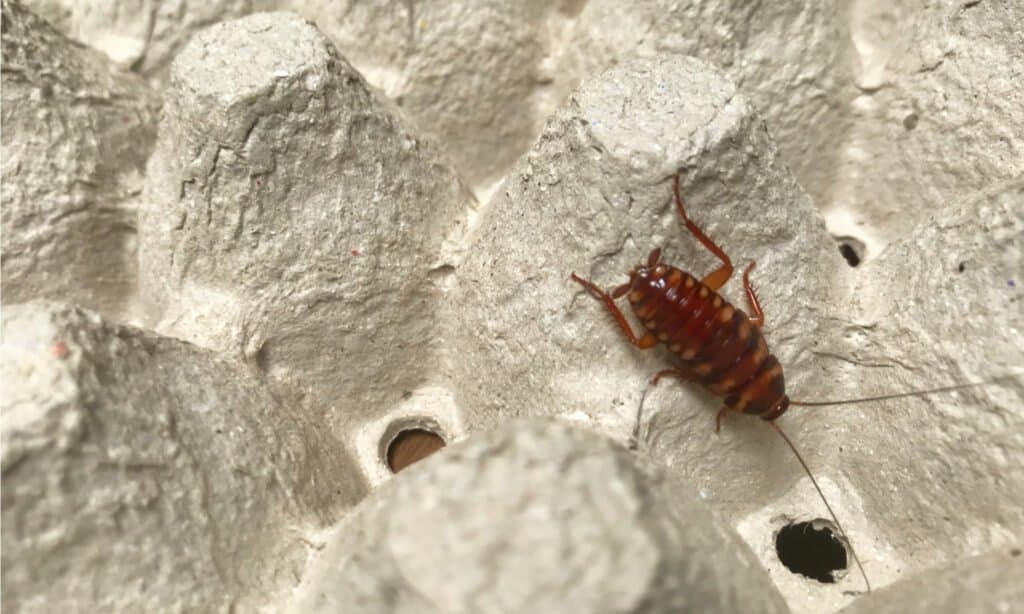
Brown banded cockroaches get their name from the two light bands they have across their dark brownish bodies
©Freedom my wing/Shutterstock.com
The smallest cockroach is the brown-banded cockroach. This roach is the smallest cockroach species found in California, and you will find it in open places like living rooms and bedrooms (because they need less moisture than other types of cockroaches). These roaches are characterized as being either tan or light brown and have two light-colored bands across their wings and abdomen. These roaches are more active at night and try to avoid light. This species of bug came to the United States in 1903, traveling from Cuba into Florida, and is now commonly seen throughout the United States. Brown-banded cockroaches lurk most commonly in kitchen cabinets and bathrooms, even behind picture frames. This species lives for 206 days on average and can reproduce at alarming rates. The brown-banded cockroach is primarily nocturnal, so this tiny roach can quickly go undetected for a long time.
Oriental Cockroach
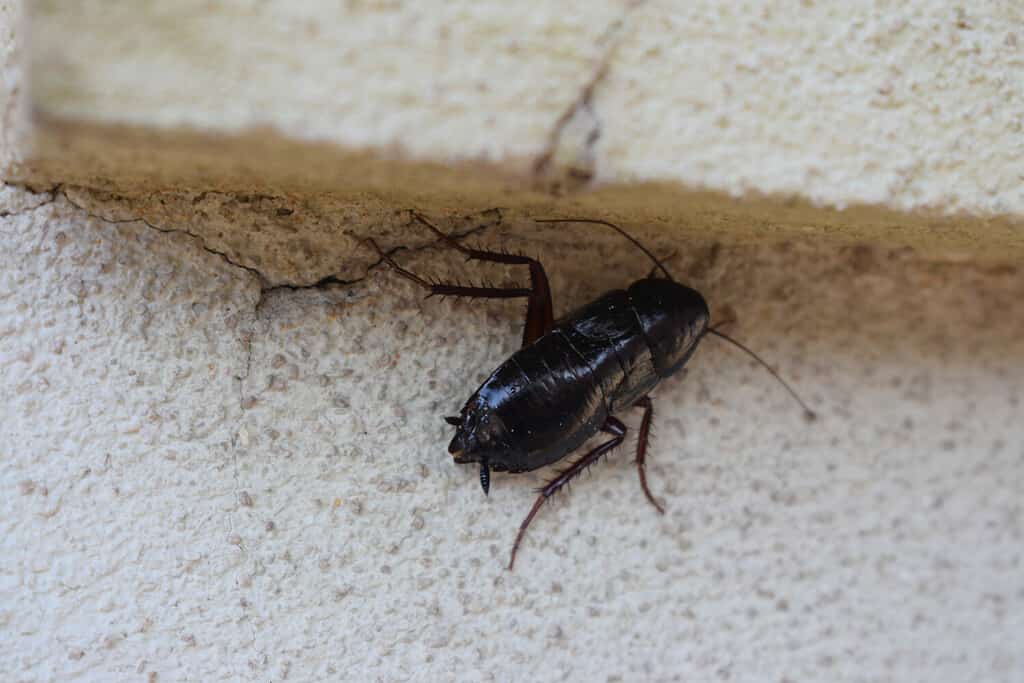
Oriental
cockroaches are also reffered to as water bugs.
©Furiarossa/Shutterstock.com
Commonly referred to as water bugs, Oriental cockroaches have a shiny dark appearance and prefer to live in damp and moist areas. You will find this roach species in sewers, drains, under debris, firewood, wet basements, or any other humid area of your home. These cockroaches gain entry into households by going under doors and through gaps beneath sliding doors. And following pipes, sewers, and drains into a structure.
Oriental cockroaches are characterized by their shiny black to dark reddish brown color. When these roaches are adults, the male and female cockroaches look very different, especially in size. The males grow 25 mm in length and have shortened, three-quarter-length wings. As a result, the male’s last few abdominal segments o their bodies are exposed. In comparison, female oriental roaches reach a length of 32 mm and have no wings. The oriental cockroach is considered the dirtiest in California and is known to spread E.coli, Salmonella, and food poisoning into people’s homes.
American Cockroach
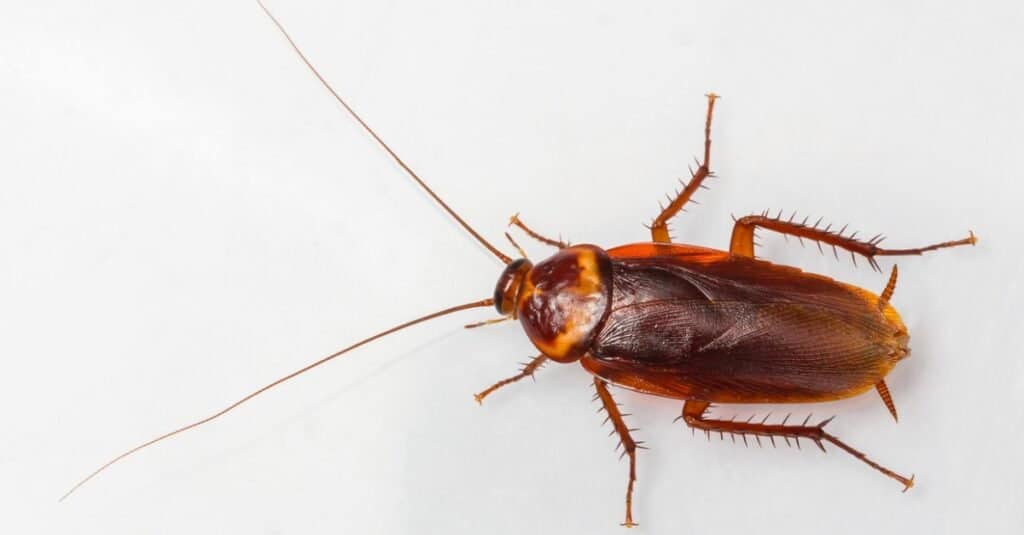
Isolated American cockroach
©iStock.com/smuay
The American cockroach is the giant house-infesting roach in California, measuring an average of 4 cm or 1.6 inches long. You will find this roach year-round in your home in California, and it generally likes warm and moist locations. Despite what its name suggests, the American cockroach is not native to North America. Instead, it is native to most parts of Africa, and some evidence suggests that American cockroaches came by ships from Africa in the early 1600s.
Adult American cockroaches are reddish-brown with a yellow band around the area behind their head. Both female and male American cockroaches have wings and can fly short distances. American cockroaches leave behind droppings in dark places where they hide. These small droppings look blunt on the ends and have ridges on the sides.
One sign of an American cockroach living in your home is the presence of egg capsules about 8 mm long and dark-colored. The egg capsules are usually found around crumbs and other food sources in basements, laundry rooms, kitchens, and behind appliances underneath cabinets. American cockroaches also release a pheromone that people describe as a musty smell, and people with sensitive noses will notice the odor around their houses.
Turkestan Cockroach
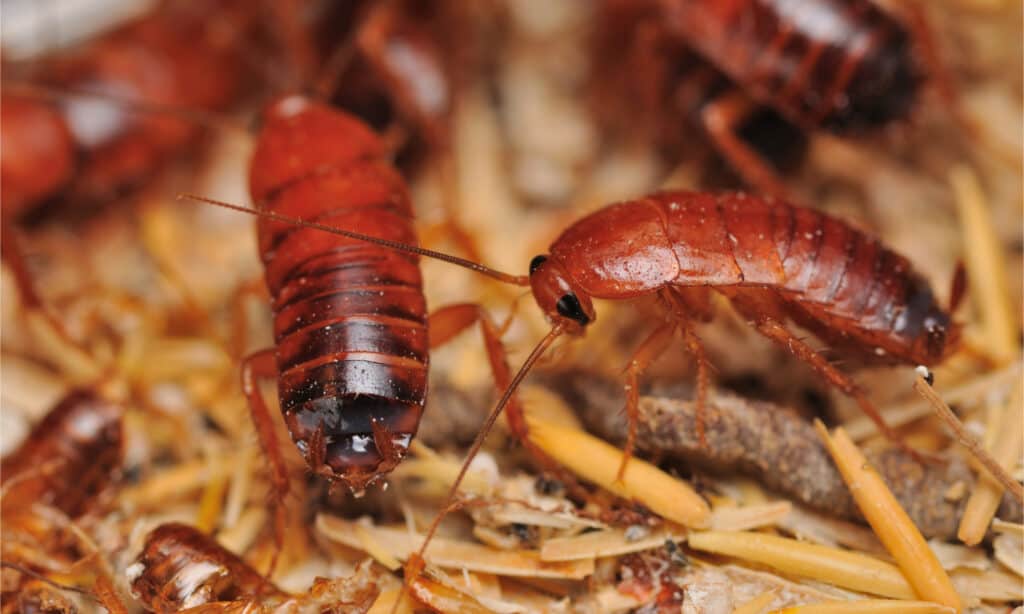
©D. Kucharski K. Kucharska/Shutterstock.com
The Turkestan Cockroach is also called the “rusty red cockroach” for the male’s red and orange-brown color. Female Turkestan cockroaches are described as dark-brown to black with light stripes. This is one of California’s more recent cockroach species, and these roaches primarily reside in outdoor areas. You will find the Turkestan cockroach in leaf litter, cracks between concrete, compost piles, potted plants, and sewer systems. These roaches will only invade your home in search of a cooler and damper spot than they will find outdoors.
How to prevent Cockroaches
Below are some helpful tips to preventing the spread of cockroaches in your home:
- Thoroughly cleaning your home every week
- Cleaning under your kitchen appliances like your fridge, oven, stove, and toaster
- Keep a lid on your trashcan and regularly empty it
- If you spill something, clean it up right away
- Store food in sealed containers
- Fix water leaks immediately
- Clean up yard debris
- Don’t let shrubs, trees, or wood piles touch your home.
What Season are Roaches the Most Prominent Concern in California?
You will find roaches year-round in California. In other states, the warm and moist spring and summer months are the roach’s favorite time for foraging and breeding. But, in states like California with wEarth climates, the cockroaches have no off-season. Cockroaches are just as active in spring when it’s hot but also in the fall when organic matter is decaying. In the cold winter months, their populations decrease, but do not go away completely. During the colder months, they find a way inside your home and hibernate.
Do Roaches Fly in California?
There is nothing scarier than a flying roach, but the good news is that even though there are over 3,600 species of insects on planet Earth, only a handful can fly. Out of all the roaches in California, the only cockroach you need to be worried about flying is the American cockroach. The American cockroach can fly with its body-length wings. The males of the Turkestan cockroach and the Brown-banded cockroach have wings but are very weak fliers.
What Attracts Cockroaches in California?
Cockroaches are natural to almost all environments and usually live close to humans. These little critters prefer damp, dark backgrounds and constantly seek water sources and decaying organic matter to feed on. Because of this, they can be found in all types of homes and building structures. What makes roaches so successful is that they are incredibly adaptable and mobile and are always looking for new environments to thrive. Spaces like storm drains, floor drains, and all types of pipes are their perfect place to live. Swerve pipes can offer both a source of water and decaying organic matter. Cockroaches prefer damp and dark spots, so the sewer system is their ideal environment. These bugs are the most active in seeking water sources and shelter when the weather gets hot and dry.
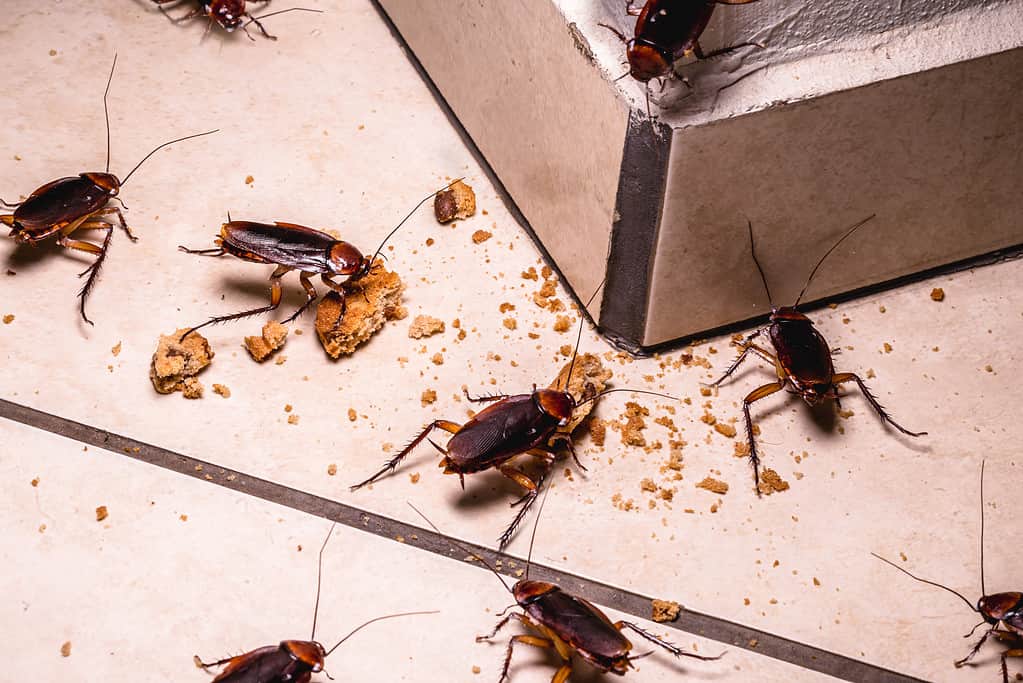
Cockroaches on the floor inside a home eating food crumbs.
©iStock.com/RHJ
How Common Are Roaches in California?
Cockroach infestations in people’s homes, garages, and yards are prevalent, especially as cockroaches become more common in California. Rich Saratain is a pest expert, and he explains that the rising temperatures in California drive roaches out of sewer systems and into people’s homes. The new Turkestan cockroach is also a significant contributor to the increasing problem.
How to Prevent Roaches inside your Home in California
Cockroaches are stubborn and resilient pests and extremely hard to get rid of. Professional pest control expertise is required for severe indoor infestations and other more significant complex cockroach problems. However, in some minor cases, you can manage cockroaches independently. To succeed, it is imperative first to find out what species of cockroach you are dealing with and where they live in your house. The more hiding places inside your home you can locate and manage, the more successful your control program will be. Most cockroaches prefer tropical, warm climates with dark hiding places and access to water.
Reducing food and water sources and any known hiding places is essential to prevent further cockroach infestations. However, insecticide spraying by itself will not eliminate cockroaches. That is why it is necessary to have a pest management plan and approach to eradicate the pests.
Traps
Glue boards or sticky traps are the best way to detect and monitor cockroach populations. You can place traps around your home and monitor them regularly. Traps are also helpful for evaluating the effectiveness of control programs. Most cockroach sticky traps at home and garden stores work well for monitoring. Cockroach traps are open at both ends for the critters to crawl into and are lined inside with sticky material. It is best to place snags where cockroaches will likely encounter them when foraging. The best places where cockroaches are likely to walk into a trap are at the corners of floors and walls and the junctions between rooms close to sites where cockroaches are suspected. For example, in the kitchen, put traps behind large appliances and in cabinets.
Sanitation
Cockroaches can only live where food and water are available to them. Even small amounts of crumbs or liquids caught between cracks provide a food source for cockroaches. Follow these sanitation measures to prevent roaches from entering your home.
- Store food in insect-proof containers like glass jars and reusable plastic containers.
- Keep garbage and trash containers with tight-fitting lids.
- Increase ventilation and eliminate plumbing leaks.
- Vacuum all the cracks and crevices of your home to remove food and debris that have been spilled and not picked up. Be sure surfaces where food and beverages have been spilled, are cleaned immediately.
- Buy a HEPA filter or triple filter your homes.
Limit Access

To keep cockroaches out of your house, store food in insect-proof containers like glass jars and reusable plastic containers.
©Furiarossa/Shutterstock.com
Prevent cockroaches from entering your home through cracks, conducts, under doors, or structural flaws. Take the following measures:
- Seal cracks and other openings outside your home to keep the critters from crawling in.
- Use door sweeps and close doors and windows during all seasons.
- Check packages for cockroaches, such as second-hand appliances, furniture, boxes, and anything recently in storage.
- Inspect food deliveries before putting them in the kitchen.
- Trim shrubbery around your home to increase light and circulation, especially near vents.
- Eliminate ivy or other dense plants growing on or near your house.
- Remove trash and stored items like lumber and firewood from near your house.
- Add gravel six to 12 inches wide around your home to reduce moisture and keep roaches out.
How to Get Rid of Roaches in California
If you have ever had to deal with an indoor infestation of cockroaches, you know they are stubborn and resilient pests. Insecticides are theEarth effective in controlling cockroaches. That, combined with sanitation and prevention practices, will limit the cockroach’s ability to establish and reinvade. However, pesticides alone will not solve the cockroach problem.
If you have to use insecticides, you must always use extreme care. Indoor chemical control is warranted only if a whole population has been established, not for just one or two intruders.
- Boric acid powder
- Borax
- Bait stations
- Diatomaceous earth
- Bait traps
- Gel baits
- Silica aerogel
- Insecticidal sprays
Home Remedies to get rid of Roaches
Suppose you have a whole population of roaches living under your roof. In that case, hiring a pest control professional from a pest control company is recommended to eradicate the cockroaches in your house. However, DIY (Do it Yourself) methods can help eliminate and prevent roach infestation in your home, all with ingredients you already have.
Boric Acid is a popular home remedy. This DIY strategy involves mixing equal parts of boric acid, confectioners’ sugar, and flour to make a dough. The baking ingredients attract the roaches, while the boric acid kills them. Next, break the dough into marble-sized balls and set them strategically around your home beneath your refrigerator and sink. Liquid concentrates are specially formulated roach deterrents. Mix them with water to dilute them and then spray them in likely hiding spots like cracks and crevices.
The photo featured at the top of this post is © iStock.com/rawintanpin
Thank you for reading! Have some feedback for us? Contact the AZ Animals editorial team.






